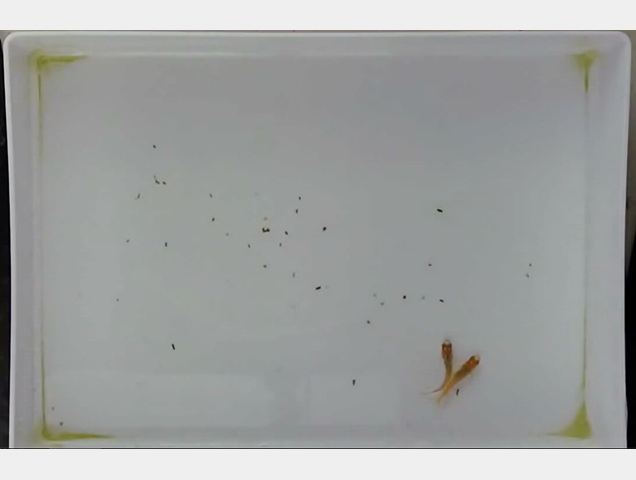Research News
Aug 7, 2025
- Science
Light up our love: Medaka courtship dynamics observed
Environmental conditions affect reproduction times in model fish
Medaka pair after lights on
Mating patterns of Japanese rice fish witnessed in the lab.
Credit: Osaka Metropolitan University

Japanese rice fish, known as medaka, are small, easy to breed, and reproduce daily, making them widely used as model organisms around the world. Until now, medaka research has mainly occurred in labs where environmental conditions and study observations are easily controlled. Unnatural environmental settings such as these bring into question the accuracy of previous behavioral findings. Therefore, this study is important for answering the fundamental question of whether the behavior of animals observed in laboratories is the same as in their natural environments.
A research team led by Specially Appointed Assistant Professor Yuki Kondo and Professor Satoshi Awata at Osaka Metropolitan University’s Graduate School of Science examined medaka reproductive behavior based on behavioral rhythms and environmental factors. Through 24-hour observations using infrared cameras and a laboratory light-dark cycle from 8 a.m. to 10 p.m., the researchers discovered medaka reproductive behavior begins in the dark period around 7 a.m. and peaks at 8 a.m.
“Previous studies may have overlooked behavioral and physiological changes that occur at night because they were conducted during daylight hours. This discovery will lead to a review of the experimental conditions for medaka as a model organism and demonstrate the importance of the natural ecology of organisms,” stated Dr. Kondo.
Further, video data revealed that 89% of reproductive behavior occurred after lights on, and overall behavior was similar to that observed in the wild. However, the peak of courtship and reproductive behavior was confirmed to be 3 to 4 hours later than in a natural environment.
“In the future, it will be necessary to investigate the reasons for the differences in reproduction times and courtship behavior in the wild and the laboratory. By introducing a system that gradually adjusts the lights and the temperature between night and day, it is possible to conduct research under conditions closer to the natural environment of medaka, thereby gaining more ecologically accurate findings in the laboratory,” stated Professor Awata.
Funding
This study was funded by the Japan Society for the Promotion of Science (JSPS) KAKENHI (22K20666 to Y. Kondo and 23H03868 to S.A.), the Sasakawa Scientific Research Grant from the Japan Science Society (2023-5013 and 2024-5010 to Y. Kondo), the Tokyo Zoological Park Society Wildlife Conservation Fund (to Y. Kondo), and the Kurita Water and Environment Foundation (24H083 to Y. Kondo).
Paper information
Journal: Scientific Reports
Title: Temporal dynamics of courtship and spawning in medaka under laboratory conditions revealed by 24 h video monitoring
DOI: 10.1038/s41598-025-11082-y
Authors: Yuki Kondo, Ryotaro Kobayashi, Yuya Kobayashi, Satoshi Awata
Published: 7 August 2025
URL: https://doi.org/10.1038/s41598-025-11082-y
Reference
Nighthawks: Wild medaka actively court female fish in wee hours
’Round midnight: Late-night romance among medaka in near natural setting
Contact
Graduate School of Science
Yuki Kondo
Email: youkikondou[at]omu.ac.jp
Satoshi Awata
Email: sa-awata[at]omu.ac.jp
*Please change [at] to @.
SDGs
